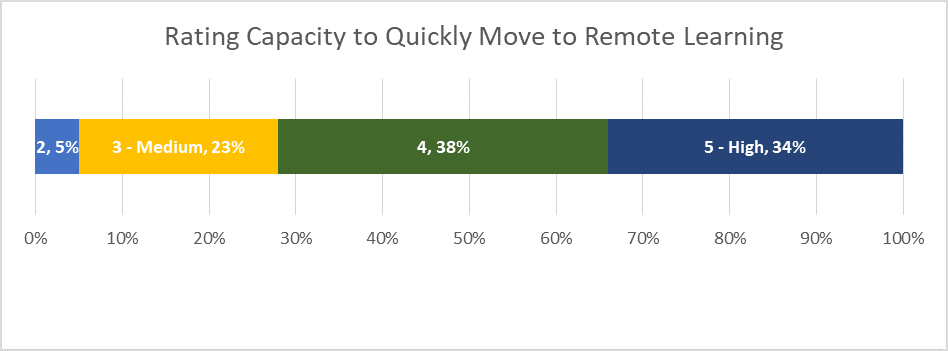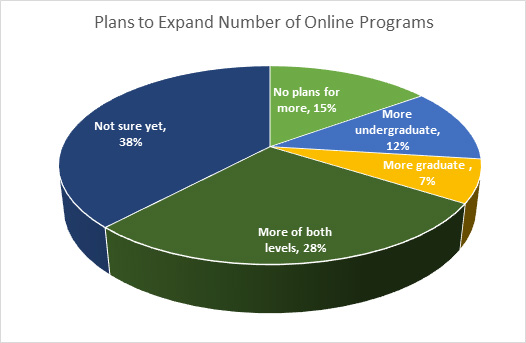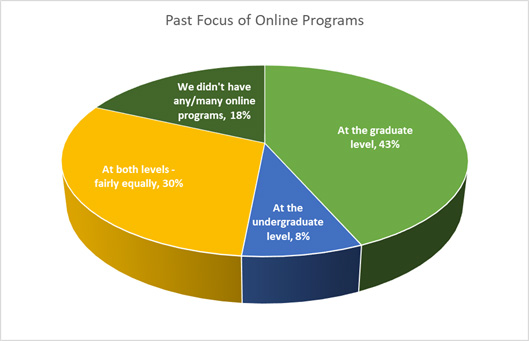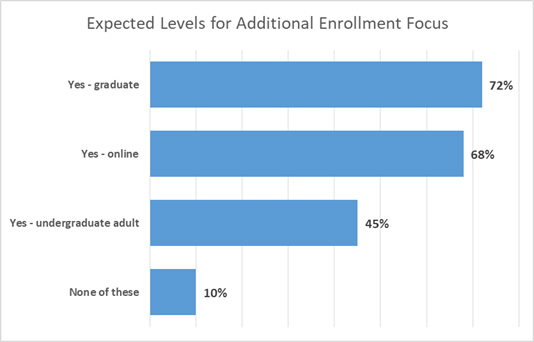enrollment
Almost 50 Percent of Schools Will Increase Number of Online Programs in Fall 2020
There has been much written about how institutions are responding to recent events—and planning for the future. Most of these stories have focused on plans for serving traditional undergraduates (who comprise about 40 percent of the undergraduate population). But what are those institutions, schools, and units that focus on graduate students (80 percent nontraditional), adult undergraduates (40 percent of all undergraduates), and online students (about 14 percent of all undergraduates and 30 percent of graduate students) planning for fall 2020?
We have instituted a monthly poll seeking feedback from enrollment, marketing, and academic stakeholders who focus on these unique audiences. The focus of this first poll was on planning for the future, and the data reflect the input of almost 70 institutions.
Here is my video recap of the analysis below and some details on next month’s graduate and online poll.
Take the next poll on “Budgets and Other Surprises”
Well prepared for the online transition
While there has been a great deal of concern about how well instruction has progressed after the quick transition to remote learning—a transition that will likely go down as the fastest in educational history—the graduate and online (GO) stakeholders felt that their institutions had strong capacity (instructional design, faculty expertise, technology infrastructure, etc.) to get it done, and done well. In fact, more than one-third gave their institution the highest rating in our poll, and no respondents used the lowest rating. This once again demonstrates that institutions with a strong background in serving adult students of all types are well positioned to confront this pandemic and the next crisis.
Exhibit 1: Rating Capacity to Quickly Move to Remote Learning

Expanding online program capacity
One of the big questions raised by the move to remote learning focuses on whether this will spur a more comprehensive move to online learning. It is clear that among these schools and units with an historic focus on serving adult students there are big plans afoot. Almost half of respondents (47 percent) indicated that they will expand the number of online programs as early as this fall (2020). Perhaps most interesting is that only 15 percent have ruled out expanding online programming, while nearly one in four are still considering it.
Although the largest proportion of respondents (43 percent) have primarily offered online graduate programs in the past (see Exhibit 3), only a small proportion will exclusively focus online expansion at the graduate level. While 38 percent have offered undergraduate programs in an online format in the past, slightly more will expand online undergraduate programs.
Exhibit 2: Plans to Expand Number of Online Programs

Exhibit 3: Past Focus of Online Programs

Student impressions of the online transition
Another question being widely considered is the effect that the unavoidably quick—and in many cases somewhat chaotic—transition to remote learning will have on students’ interest in online programs. In order to understand the consequences, we must consider a core distinction between those who were thrust into remote learning with no previous desire to do so:
- Primarily traditional undergraduate students who comprise only about 40 percent of almost 17 million undergraduates according to an ACE study
- Students who may have considered it, but to date had not done so—post-traditional learners of any age who cannot enroll in a traditional, full time, residential experience who comprise as much as 60 percent of undergraduates and 80 percent of graduate students.
The difference between these two populations can be seen in the responses from our graduate, adult, and online stakeholders who believe that recent exposure to remote/online instruction is likely to be the “nudge” that so many adults may have needed to embrace online. Almost 60 percent of respondents indicated that they thought recent experiences would increase interest in online education. One respondent called it the, “Mikey moment… try it and you’ll like it.”
Exhibit 4: Impact of Remote Learning on Student Interest

Comments from respondents
- I think that a new segment of people will now consider online education because a) they are worried that in-person instruction could be moved remotely again in the future; and/or b) they are now thinking more broadly about the pros and cons of the on-campus experience and total cost.
- Recent experiences for many will be weighed alongside many factors that will give (at least non-traditional students) a positive feeling about online: Fear of being with large numbers of people, fear of the virus, concern over cost-effectiveness. There are also parents not wanting their children to be on campus, and now students will know how online works, they can work and go to school, etc.)
- There has always been greater interest in online among working professionals/nontraditional students. But many have had reservations about trying online. Having more flexible options available (now) may be what makes them decide to apply to an online program when they may not have felt able to do so in the past.
- Students will now have seen that online can be done, and if done right, it can be very good. Hopefully out of four or five classes, one of them was really good. Believe it or not, that could be all that it takes to make a convert.
Additional focus on graduate and online programs
In a March 2020 RNL survey of the broadest range of enrollment and marketing leaders, about 40 percent of institutions indicated that they thought online programs would be leveraged to mitigate other enrollment declines, about 25 percent thought that graduate programs would be leveraged, and about 25 percent said undergraduate adult programs would be leveraged (while 50+ percent said traditional undergraduate programs would be the focus).
Our poll of graduate, adult, and online stakeholders tell a different tale. More than 70 percent say that graduate programs will play a greater role in mitigating enrollment loses, while nearly as many indicate that online programs will do so. Undergraduate adult programs were not selected by quite as many, and yet almost half suggested that such programs would help stabilize enrollment.
Exhibit 5: Expected Levels for Additional Enrollment Focus

In my 20 years of working with institutions with a specific focus on helping them understand the most critical demand and supply dynamics associated with being a success in attracting these populations, I know that “demand” for our services was always highest when the funnel of traditional undergraduates was the most unstable. This time is no different, with professionals who work with adult students of all types ready and prepared to (yet again) help their institutions through this most challenging of times.
The institutions that best understand their audience will be best positioned to serve these adult students. Their needs are different, their demands are different, and their motivations are different. They have too many choices available to them today—whether they are interested in online or classroom programs—for them to settle for something that doesn’t meet their needs.
Take our next poll and talk to us about optimizing your online programs
RNL’s next poll is focuses on budgets. I invite you to take this 10-minute survey—the first 100 respondents will be receive a gift card. Take the poll.
Our enrollment experts are also here for you and ready to talk about your strategies for graduate and online enrollment. Contact us and we’ll arrange a convenient time to talk with you.

